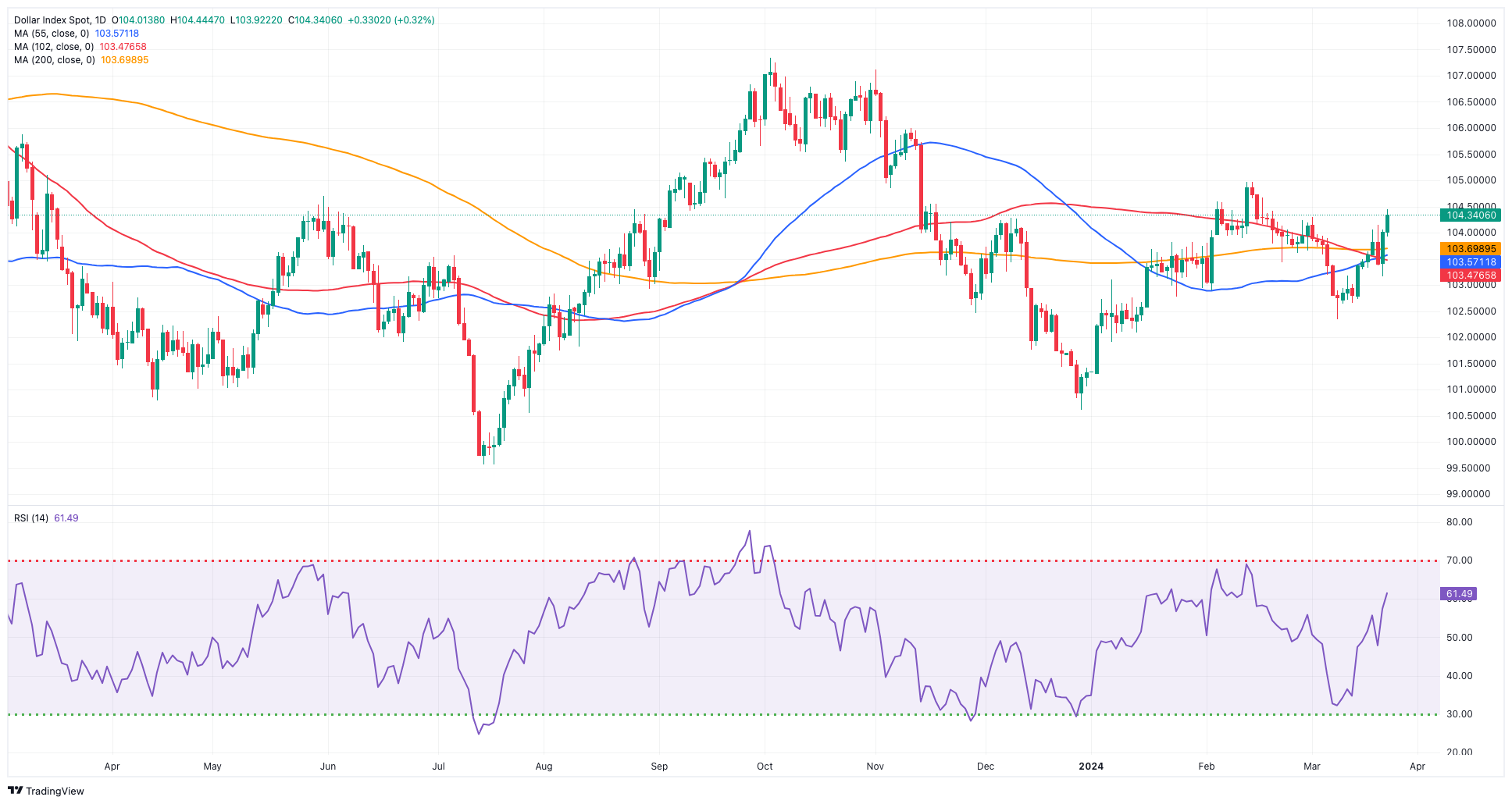- The USD Index (DXY) advanced further north of 104.00.
- The Federal Reserve matched consensus and left rates intact.
- Investors will now look at US inflation tracked by the PCE.
- A rate cut in May is not entirely off the table.
Throughout another notably productive week, the US Dollar (USD) successfully regained more stability, concluding its second consecutive week with gains and managing to reclaim the area beyond the 104.00 barrier when tracked by the US Dollar Index (DXY).
Simultaneously, the index managed to put further distance from the recent breakout of the critical 200-day Simple Moving Average (SMA) at 103.70, opening the door to continuation of the bullish stance for the time being.
Curiously, the weekly advance in the Greenback came on the back of some loss of momentum in the recent rally in US yields across different time frames, which seems to have gathered extra pace in the wake of the FOMC event. This move higher, instead, appears to have been largely on the back of the sharp sell-off in the Japanese Yen, which was magnified by the BoJ’s dovish hike earlier in the week.
Fed rate cut in June looks likely…but what about May?
The weekly price action around the Greenback was dominated by the FOMC event on March 20.
On the latter, the Federal Reserve (Fed) left its fed funds target range (FFTR) unchanged at 5.00%-5.25% as anticipated. In addition, the Committee increased its core Personal Consumption Expenditures (PCE) projections for 2024 to a range of 2.5-2.6%, up from the previous range of 2.4-2.5% set in December, and raised its interest rate projections for 2025 and the subsequent years.
According to the updated Dot Plot, the Committee still sees three interest rate cuts this year vs. some expectations of only two rate reductions, particularly in light of the recent bounce in inflation. While consumer prices continue to run above the Fed’s goal, the bank is confident that they will continue to drift lower and eventually reach the 2% goal.
During his press briefing, Chair Jerome Powell struck a dovish tone, commending the economy's advancement and highlighting strong consumer demand and the resurgence of supply chains. Nonetheless, elevated interest rates have impeded business investments. Despite this challenge, the labour market continues to tighten, with supply and demand showing improved alignment. Powell hinted at the possibility of rate reductions later in the year, underscoring the importance of ensuring confidence in the sustained decrease in inflation before implementing such measures.
Fast-forwarding, it could be the case of a faster drop in US inflation in the next couple of months along with further cooling of the labour market, which carries the potential to bring forward the potential start of the Fed’s easing cycle at its May 1 event.
The FedWatch Tool, operated by CME Group, substantiates the prevailing perspective, signaling that the likelihood of a 25 bps reduction in June stands at approximately 62% and nearly 15% for the month of May.
Further cautiousness is expected to kick in ahead of PCE
Investors’ attention now shifts to the publication of extra US inflation data, this time from the Personal Consumption Expenditures (PCE) at the end of next week. These readings will come along with some other key fundamentals, including another revision of Q4 GDP Growth Rate, Durable Goods Orders, the usual weekly Initial Jobless Claims and the final Michigan Consumer Sentiment gauge.
Against that backdrop, the Greenback could enter a consolidative phase, while bulls should keep targeting the 2024 YTD top of 104.97 recorded on February 14.
Central bank outlook: Interest rate trends and currency strength
When examining central banks and inflation dynamics among the G10, the Fed and the European Central Bank (ECB) are still anticipated to decrease their interest rates around the summer season along with maybe the Bank of England (BoE). Conversely, the Reserve Bank of Australia (RBA) is expected to initiate its easing cycle later in the year. Despite raising its policy rate by 10 basis points after 17 years during its March 19 meeting, the Bank of Japan (BoJ) remains an outlier.
Additionally, with the growing likelihood of monetary easing by both the ECB and the Fed occurring concurrently, the stronger position of US fundamentals is projected to uphold the Dollar's strength against its G10 counterparts, particularly the Euro, for the foreseeable future.
DXY technical outlook
The daily chart indicates an impending resistance area near the 2024 peak at 104.97, recorded on February 14. Progressing beyond this point, a minor obstacle lies at the weekly pinnacle of 106.00, marked on November 10, followed by the November high of 107.11, set on November 1.
In the opposite direction, the March low of 102.35 presents a notable support zone. Should the DXY decline further, it might approach its December low of 100.61, observed on December 28, preceding the significant 100.00 threshold and the 2023 low of 99.57 recorded on July 14.
In the broader perspective, maintaining a position above the 200-day Simple Moving Average (SMA) bodes well for a positive outlook.

Economic Indicator
United States Personal Consumption Expenditures - Price Index (MoM)
The Personal Consumption Expenditures (PCE), released by the US Bureau of Economic Analysis on a monthly basis, measures the changes in the prices of goods and services purchased by consumers in the United States (US).. The MoM figure compares prices in the reference month to the previous month. Price changes may cause consumers to switch from buying one good to another and the PCE Deflator can account for such substitutions. This makes it the preferred measure of inflation for the Federal Reserve. Generally speaking, a high reading is bullish for the US Dollar (USD), while a low reading is bearish.
Read more.US Dollar price this week
The table below shows the percentage change of US Dollar (USD) against listed major currencies this week. US Dollar was the weakest against the Canadian Dollar.
| USD | EUR | GBP | CAD | AUD | JPY | NZD | CHF | |
| USD | 0.57% | 0.99% | 0.38% | 0.53% | 1.50% | 1.34% | 1.65% | |
| EUR | -0.58% | 0.40% | -0.20% | -0.04% | 0.92% | 0.79% | 1.06% | |
| GBP | -0.99% | -0.41% | -0.61% | -0.45% | 0.53% | 0.37% | 0.67% | |
| CAD | -0.38% | 0.19% | 0.61% | 0.14% | 1.12% | 0.96% | 1.26% | |
| AUD | -0.54% | 0.04% | 0.45% | -0.16% | 0.97% | 0.81% | 1.10% | |
| JPY | -1.53% | -0.95% | -0.46% | -1.14% | -0.99% | -0.16% | 0.14% | |
| NZD | -1.38% | -0.79% | -0.39% | -0.99% | -0.84% | 0.14% | 0.28% | |
| CHF | -1.66% | -1.07% | -0.68% | -1.28% | -1.13% | -0.14% | -0.28% |
The heat map shows percentage changes of major currencies against each other. The base currency is picked from the left column, while the quote currency is picked from the top row. For example, if you pick the Euro from the left column and move along the horizontal line to the Japanese Yen, the percentage change displayed in the box will represent EUR (base)/JPY (quote).
Information on these pages contains forward-looking statements that involve risks and uncertainties. Markets and instruments profiled on this page are for informational purposes only and should not in any way come across as a recommendation to buy or sell in these assets. You should do your own thorough research before making any investment decisions. FXStreet does not in any way guarantee that this information is free from mistakes, errors, or material misstatements. It also does not guarantee that this information is of a timely nature. Investing in Open Markets involves a great deal of risk, including the loss of all or a portion of your investment, as well as emotional distress. All risks, losses and costs associated with investing, including total loss of principal, are your responsibility. The views and opinions expressed in this article are those of the authors and do not necessarily reflect the official policy or position of FXStreet nor its advertisers. The author will not be held responsible for information that is found at the end of links posted on this page.
If not otherwise explicitly mentioned in the body of the article, at the time of writing, the author has no position in any stock mentioned in this article and no business relationship with any company mentioned. The author has not received compensation for writing this article, other than from FXStreet.
FXStreet and the author do not provide personalized recommendations. The author makes no representations as to the accuracy, completeness, or suitability of this information. FXStreet and the author will not be liable for any errors, omissions or any losses, injuries or damages arising from this information and its display or use. Errors and omissions excepted.
The author and FXStreet are not registered investment advisors and nothing in this article is intended to be investment advice.
Recommended Content
Editors’ Picks
EUR/USD stays in positive territory above 1.0850 after US data

EUR/USD clings to modest daily gains above 1.0850 in the second half of the day on Friday. The improving risk mood makes it difficult for the US Dollar to hold its ground after PCE inflation data, helping the pair edge higher ahead of the weekend.
GBP/USD stabilizes above 1.2850 as risk mood improves

GBP/USD maintains recovery momentum and fluctuates above 1.2850 in the American session on Friday. The positive shift seen in risk mood doesn't allow the US Dollar to preserve its strength and supports the pair.
Gold rebounds above $2,380 as US yields stretch lower

Following a quiet European session, Gold gathers bullish momentum and trades decisively higher on the day above $2,380. The benchmark 10-year US Treasury bond yield loses more than 1% on the day after US PCE inflation data, fuelling XAU/USD's upside.
Avalanche price sets for a rally following retest of key support level

Avalanche (AVAX) price bounced off the $26.34 support level to trade at $27.95 as of Friday. Growing on-chain development activity indicates a potential bullish move in the coming days.
The election, Trump's Dollar policy, and the future of the Yen

After an assassination attempt on former President Donald Trump and drop out of President Biden, Kamala Harris has been endorsed as the Democratic candidate to compete against Trump in the upcoming November US presidential election.